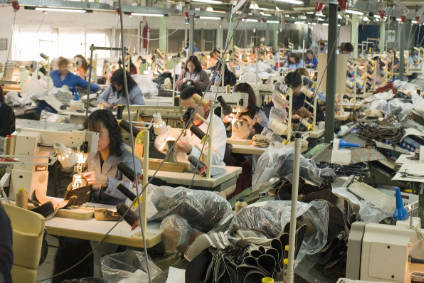
Major clothing and footwear companies are failing to tackle the exploitation of workers in their supply chains, according to a new benchmark report that measures companies’ efforts to address forced labour.
The analysis by KnowTheChain gives the apparel and footwear sector an average overall score of just 37 out of 100.
While this shows improvement from the sector since the previous benchmark in 2016, the majority of the companies scored poorly – with more than two-thirds scoring below 50/100.
The research notes industry-wide progress is uneven and lacking on key issues such as responsible recruitment – one of the areas with the most direct impact on vulnerable workers’ lives.
Despite decades of public scrutiny over labour conditions in the industry, workers, particularly migrants and women, are often exploited through force, fraud or coercion. Many work for little or no pay, cut off from their homes or families, and with restrictions on their movement or opportunities for recourse.
Compounding the issue, workers are often charged exorbitant recruitment fees that they can never repay, further trapping them in debt bondage and forced labour.
“No one should have to pay for their job,” says Kilian Moote, project director at KnowTheChain, which is a resource for understanding and addressing forced labour abuses in the supply chain. “We need to see stronger action from apparel and footwear brands to ensure vulnerable workers are recruited ethically and that their voices and grievances are heard across all their supply chains.”
The apparel and footwear sector is increasingly reliant on migrant labour. For example, migrant workers make up as much as 77% of the Jordanian apparel workforce and 44% of the Mauritius apparel workforce.
Migrant workers are at particular risk of exploitation, as employers often hold their passports to stop them from travelling freely and enable recruitment agencies to charge hefty fees. In Taiwan, recruitment agents were found to charge migrant workers up to US$7,000 for jobs in fabric mills.
The report finds 18 companies scored 0/100 on recruitment, which measures a company’s approach to reducing the risk of exploitation of workers by recruitment agencies, eliminating workers’ payment of fees during the recruitment processes, and protecting the rights of migrant workers.
The report also highlights top performing companies. Adidas had the strongest overall score (92/100), followed by Lululemon (89/100), which overtook Gap Inc (75/100) to secure the second highest spot in the ranking.
Adidas and Lululemon are the only companies that require the direct employment of workers in their supply chains, the report says, thus eliminating the risk of exploitation through employment agencies. These companies also provided evidence that their grievance mechanism is accessible to and actively used by workers in the second tier of their supply chains.
The lowest scoring companies include luxury brands Prada (5/100) and Salvatore Ferragamo (13/100), footwear companies Skechers (7/100) and Foot Locker (12/100), and suppliers Eclat Textile and Yue Yuen, both with 1/100.
“A single pair of shoes made from rubber, leather, metal, and cotton may have passed through dozens of hands that belong to victims of forced labour,” Moote adds. “All apparel and footwear brands are at risk of forced labour and it’s concerning to see the industry is still not doing enough to protect vulnerable workers around the world.”
Despite the results, KnowTheChain last year concluded that apparel companies tend to be more advanced in their efforts to eradicate forced labour in their supply chains compared with food and beverage companies.
Click on the following link to view the 2018 Apparel and Footwear Benchmark, which assesses 43 apparel and footwear companies across seven themes.



